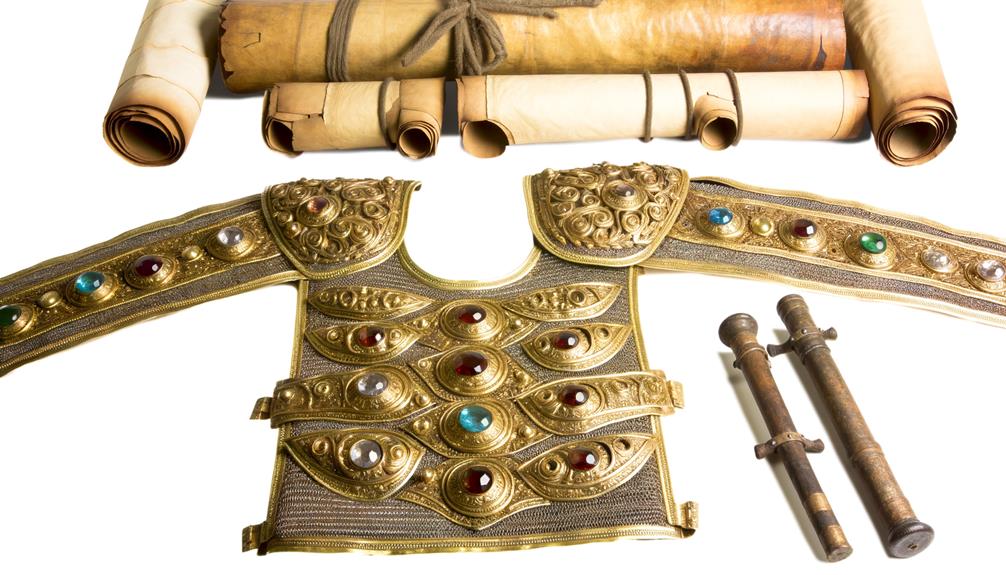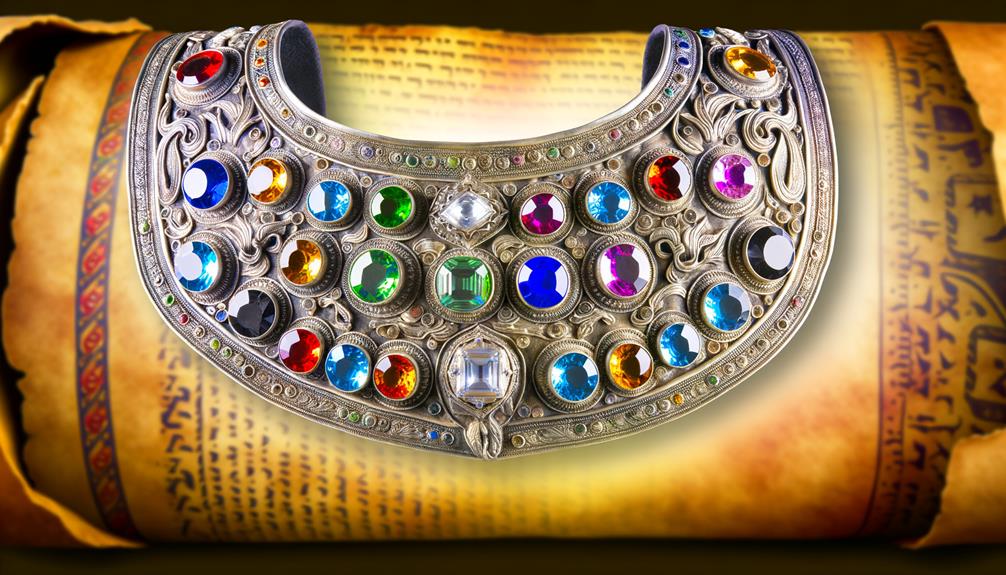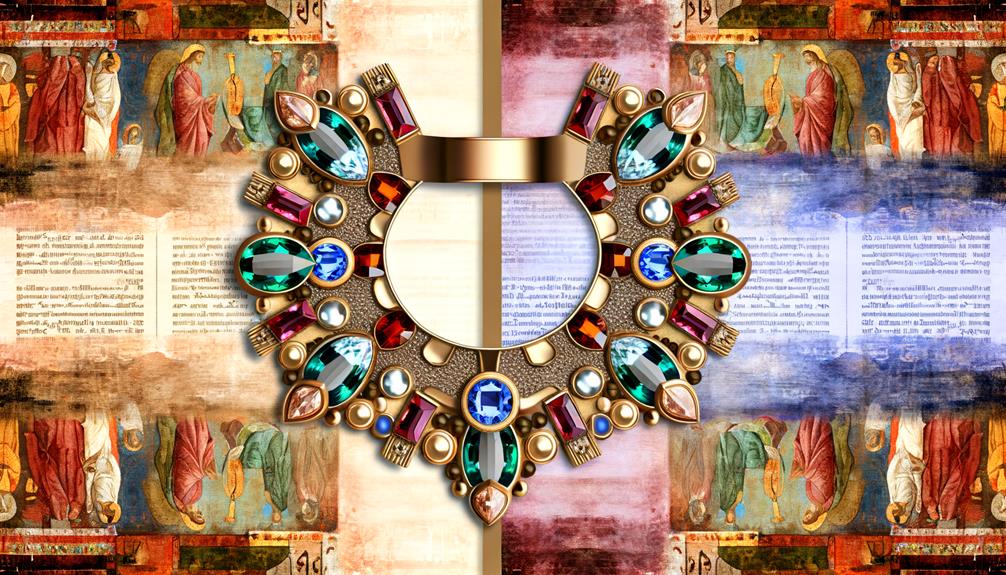Breastplate Meaning in the Bible: Righteousness
In the Bible, the breastplate carries deep symbolic significance, primarily associated with protection, righteousness, and divine authority. Significantly featured in both the Old and New Scriptures, it is described as an essential part of the High Priest’s vestments in ancient Israel, adorned with twelve stones representing the twelve tribes.
These stones symbolized unity and collective identity, further integrating divine elements like the Urim and Thummim for decision-making. As a metaphor for spiritual armor, the breastplate emphasizes moral integrity and divine safeguarding.
Exploring its materials, craftsmanship, and theological themes offers richer insights into this profound symbol.

Breastplate Meaning in the Bible: Spiritual Symbolism and Purpose
| Aspect | Details |
|---|---|
| Definition | A protective covering for the chest, symbolizing defense and righteousness |
| Key Bible Reference | Breastplate of the High Priest (Exodus 28), Breastplate of Righteousness (Ephesians 6:14) |
| Symbolic Meaning | Protection of the heart, righteousness, divine truth, and priestly authority |
| Spiritual Insight | God equips believers to guard their hearts through faith and righteousness |
| Moral Lesson | Living righteously protects our spiritual core and strengthens our walk with God |
Biblical References to Breastplate

In the Bible, the breastplate is frequently mentioned in both the Old and New Scriptures, serving as a significant symbol of protection, righteousness, and divine authority.
In the Old Covenant, the breastplate is often associated with warfare and divine protection, as seen in Isaiah 59:17, where God dons a breastplate of righteousness.
The New Covenant continues this motif, particularly in Ephesians 6:14, where Paul instructs believers to ‘put on the breastplate of righteousness’ as part of the spiritual armor of God.
These references are not merely literal but also metaphorical, representing moral integrity and divine safeguarding.
Consequently, the breastplate encapsulates a profound theological concept, intertwining physical protection with spiritual fortitude and moral rectitude.
High Priest’s Breastplate

Central to the attire of the High Priest in ancient Israel, the breastplate, also known as the ‘breastplate of judgment,’ held not only aesthetic and ceremonial significance but also profound theological and judicial implications.
This sacred garment, adorned with twelve distinct stones representing the twelve tribes of Israel, was pivotal in the priestly duties of mediation and divine communication. It symbolized the High Priest’s role in seeking God’s guidance for the nation through the Urim and Thummim, instruments of divine decision-making embedded within the breastplate.
| Aspect | Description |
|---|---|
| Significance | Theological, Judicial, Ceremonial |
| Symbolism | Representation of the Twelve Tribes of Israel |
| Function | Mediation, Divine Communication |
| Instruments Included | Urim and Thummim for seeking divine decisions |
This thorough understanding underscores the multidimensional role of the breastplate.
Materials and Construction

The construction of the High Priest’s breastplate, as described in biblical texts, exemplifies sophisticated ancient craftsmanship techniques, particularly in its use of intricate weaving and metalworking skills.
Central to its design were the symbolic gemstone inlays, each representing one of the twelve tribes of Israel, signifying not only the cultural but also the spiritual significance embedded within the artifact.
The meticulous selection and arrangement of these materials underscore the theological importance of the breastplate in ancient religious practices.
Ancient Craftsmanship Techniques
Crafting the biblical breastplate required meticulous selection of materials, including gold, blue, purple, and scarlet yarn, and fine linen, demonstrating an intricate blend of artistry and divine instruction.
Ancient artisans employed sophisticated weaving techniques to create this sacred garment. Gold was hammered into thin sheets and cut into threads, which were then interwoven with dyed yarns of specific colors.
The use of linen, a durable and fine fabric, provided a robust base. Techniques such as brocading and embroidery enabled the craftsmen to achieve the intricate designs commanded in the Book of Exodus.
The precision in material preparation and assembly underscored the breastplate’s sanctity, ensuring it met the exacting standards set forth by divine decree.
Symbolic Gemstone Inlays
Integral to the biblical breastplate were the twelve gemstone inlays, each meticulously selected and arranged, symbolizing the twelve tribes of Israel and embodying significant theological and cultural meanings. The stones were set in four rows of three, each stone bearing the name of a tribe, consequently encapsulating the unity and diversity of the Israelite confederation.
The materials used were of the highest quality, reflecting both divine instruction and artisan skill. Each gemstone’s color and type were believed to have specific spiritual connotations, enhancing the breastplate’s sanctity and role in divine communication.
| Gemstone | Tribe |
|---|---|
| Ruby | Reuben |
| Sapphire | Simeon |
| Emerald | Levi |
| Turquoise | Judah |
| Lapis Lazuli | Issachar |
| Onyx | Zebulun |
| Jasper | Dan |
| Agate | Naphtali |
| Amethyst | Gad |
| Beryl | Asher |
| Topaz | Joseph |
| Jacinth | Benjamin |
Urim and Thummim

The Urim and Thummim, often embedded within the high priest’s breastplate, functioned as sacred instruments for divine decision-making, reflecting their role in seeking God’s guidance on critical matters.
Their presence within the priestly garment underscores not only the sanctity of the high priest’s duties but also symbolizes the intersection of divine will and human leadership.
This interplay highlights the theological significance of these objects in conveying divine authority and direction within the biblical narrative.
Divine Decision-Making Tools
Utilized by the ancient Israelites, the Urim and Thummim served as enigmatic instruments of divine decision-making within the context of the priestly breastplate. These sacred objects, embedded within the high priest’s breastplate, were integral to seeking Yahweh’s guidance on critical matters.
Though their exact nature remains elusive, scholars suggest they operated as casting lots or stones that illuminated to reveal divine will. Their usage is mentioned specifically in the Old Scriptures regarding decisions on leadership and warfare.
- Mysterious Mechanism: The precise method of interpretation remains a subject of scholarly debate.
- Divine Consultation: They provided a direct means to discern God’s will.
This understanding underscores their profound significance in biblical history.
Priestly Garment Symbolism
Embedded within the high priest’s breastplate, the Urim and Thummim symbolize the profound intersection of divine authority and priestly duty in ancient Israelite culture. These enigmatic elements facilitated direct communication with God, enabling the high priest to discern His will in critical communal matters.
The precise nature of Urim and Thummim remains a subject of scholarly debate, yet their role in the decision-making process underscores their sacred function.
| Aspect | Urim | Thummim |
|---|---|---|
| Function | Divine Guidance | Divine Truth |
| Placement | High Priest’s Breastplate | High Priest’s Breastplate |
| Biblical References | Exodus 28:30, Numbers 27:21 | 1 Samuel 28:6, Ezra 2:63 |
Their integration into the priestly garments underscores the theological importance of divine direction in Israelite governance and worship.
Symbolism of Twelve Tribes

Each stone on the High Priest’s breastplate carries profound significance, representing one of the twelve tribes of Israel and encapsulating the collective identity and divine heritage bestowed upon them.
This intricate arrangement is more than ornamental; it signifies the unity and distinctiveness of each tribe within the nation of Israel. The twelve stones, each inscribed with a tribe’s name, serve as a tangible reminder of the covenant between God and His people.
Analyzing these stones reveals:
- Historical Legacy: Each tribe’s unique history and role in Israel’s formation.
- Divine Order: The stones’ arrangement reflects God’s ordained structure for His people.
These elements highlight the multifaceted symbolism of the breastplate.
Spiritual Significance

The breastplate worn by the High Priest holds profound spiritual significance, symbolizing the intermediatory role between the divine and the Israelites, and embodying the perpetual presence of God amidst His people.
This sacred garment, adorned with twelve gemstones representing the tribes of Israel, underscores the holistic inclusion of the community in divine worship and guidance.
The Urim and Thummim, placed within the breastplate, facilitated divine communication, thereby reinforcing the High Priest’s role as a conduit for God’s will.
The meticulous design and placement of the breastplate emphasize the importance of purity, order, and divine mandate in religious observance, reflecting a theologically rich tapestry that integrates material symbols with spiritual truths.
This emblematic vestment, consequently, encapsulates the covenantal relationship between God and His chosen people.
Modern Interpretations

Modern interpretations of the High Priest’s breastplate often explore its theological and symbolic relevance in contemporary religious practices, drawing parallels between ancient rituals and modern spiritual understandings. Scholars investigate how the twelve stones, representing the tribes of Israel, offer insights into community, unity, and divine guidance.
The breastplate’s craftsmanship is also seen as a metaphor for moral and spiritual integrity, urging believers to embody these virtues in daily life. Additionally, the Urim and Thummim, embedded in the breastplate, are interpreted as symbols of divine wisdom and decision-making.
- Symbolic Unity: Reflects the interconnectedness of religious communities.
- Moral Integrity: Serves as a reminder of ethical living.
Conclusion
The biblical breastplate, rich in historical and spiritual significance, serves as a multifaceted symbol in religious texts.
With roots in the High Priest’s sacred attire, its intricate materials and construction, alongside the enigmatic Urim and Thummim, underscore its divine purpose.
The twelve stones, representing the tribes of Israel, weave a tapestry of unity and identity.
In contemporary interpretations, the breastplate’s essence continues to illuminate theological discourse, akin to a beacon guiding the faithful through the corridors of spiritual understanding.






